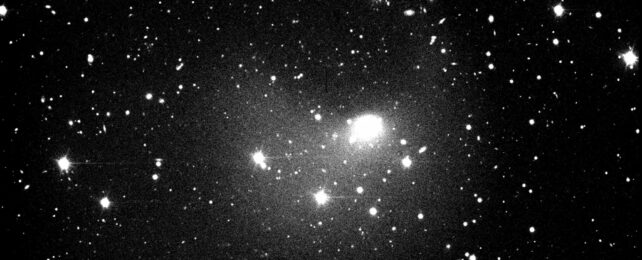The so-called "Devil Comet" is barreling past Earth and exploding on its way around the sun, but a researcher who studies such phenomenon told Insider that while the comet is large and unusual, its menacing name — a reference to the appearance of horns — does not mean it poses any threat to the third planet from the sun.
Known to scientists as 12P/Pons-Brooks, the comet last made an appearance in Earth's skies more than 70 years ago. Judging by its brightness, astronomers have estimated that the solid part of the comet, or its nucleus, is about 12.4 miles across — roughly twice the size of Mount Everest.
Typically, comets are between 0.6 and 1.8 miles wide, according to Teddy Kareta, a postdoctoral researcher at Lowell Observatory in Flagstaff, Arizona.
"We know it's big. We know it's an outlier. We know it's rare," Kareta told Insider.
We also know it is likely to be most visible next spring, but not because it's barreling toward Earth in another extinction-level event. In fact, Kareta said, at its closest the comet will still be about one-and-half astronomical units away, or put another away: even further from Earth than the sun.
"It might be bright enough that you can see with your naked eye or with binoculars, but that's not because it's going to be super close," Kareta said. "It's because it's just generally very bright."
Indeed, the comet is both bright and highly unusual. Its "horns" are actually tails of gas and dust formed by an odd series of explosive outbursts that scientists still do not understand. Two such outbursts have been witnessed this year: first in July, then earlier this month.
An "outburst," according to Kareta, is "where comets suddenly get much more active," throwing off tons of gas and dust in a short period of time. When this happens, "the comet brightens really rapidly and then sort of fades back to the brightness it had before," he said. "And in Pons-Brooks, these are really, really bright — really, really large outbursts. And this is what makes this comet so interesting to scientists."
These outbursts have been particularly interesting due to their frequency and where they occurred. One theory is that comets contain forms of ice that, when exposed for the first time to heat from the sun, cause volatile explosions. But those explosions have typically been observed closer to the sun, and not often. According to Kareta, "it might happen twice in five years."
The Pons-Brooks comet, by contrast, is exploding relatively often and, confoundingly, far away from the sun. Right now, it's further off than Mars, Kareta noted, where "it's just not that warm." That raises the question: "Where's the energy coming from that powers these kinds of large outbursts? And the fact that it can apparently do so many, so often?"
The comet is expected to reach peak brightness in mid-April 2024 as it continues on its 71.2-year journey around the sun. Astronomers, professional or otherwise, are looking forward to it.
"I think a lot of people are really excited about it," Kareta said.
This article was originally published by Business Insider.
More from Business Insider: